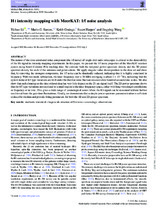| dc.contributor.author | Li, Y | |
| dc.contributor.author | Santos, M.G | |
| dc.contributor.author | Grainge, K | |
| dc.date.accessioned | 2021-05-11T12:30:31Z | |
| dc.date.available | 2021-05-11T12:30:31Z | |
| dc.date.issued | 2021 | |
| dc.identifier.citation | Li, Y. et al. (2021). H i intensity mapping with MeerKAT: 1/f noise analysis. Monthly Notices of the Royal Astronomical Society,501(3), 4344-4358 | en_US |
| dc.identifier.issn | 0035-8711 | |
| dc.identifier.uri | 10.1093/mnras/staa3856 | |
| dc.identifier.uri | http://hdl.handle.net/10566/6143 | |
| dc.description.abstract | The nature of the time correlated noise component (the 1/f noise) of single dish radio telescopes is critical to the detectability of the H i signal in intensity mapping experiments. In this paper, we present the 1/f noise properties of the MeerKAT receiver system using South Celestial Pole tracking data. We estimate both the temporal power spectrum density and the 2D power spectrum density for each of the antennas and polarizations. We apply singular value decomposition to the data set and show that, by removing the strongest components, the 1/f noise can be drastically reduced, indicating that it is highly correlated in frequency. With two-mode subtraction, the knee frequency over a 20\, MHz averaging is about 3\times 10^{-3}\, {\rm Hz}, indicating that the system induced 1/f-type variations are well under the thermal noise fluctuations over a few hundred seconds time-scales. We also show that such cleaning on the time ordered data has very little impact on the 21-cm signal itself. | en_US |
| dc.language.iso | en | en_US |
| dc.publisher | Oxford University Press | en_US |
| dc.subject | Cosmology: observations | en_US |
| dc.subject | Large-scale structure of universe | en_US |
| dc.subject | Methods: statistical | en_US |
| dc.subject | H i intensity mapping | en_US |
| dc.title | H i intensity mapping with MeerKAT: 1/f noise analysis | en_US |
| dc.type | Article | en_US |

